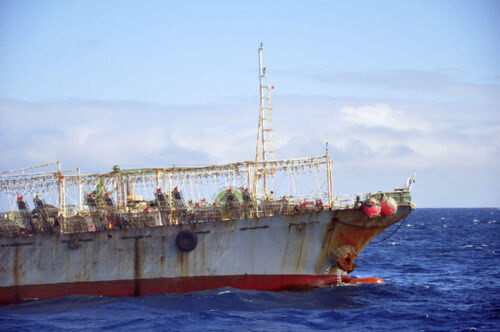In 2016, 33 countries agreed to establish a global network of scientifically supported Marine Protected Areas (MPAs) that will increase the amount of ocean area protected from the current 2 percent to 10 percent by the year 2020. MPAs either restrict human activity such as fishing, or they prohibit it all together. But the question is: do they work?
With relatively few studies on the impacts of massive MPAs on both marine species and fishermen, skeptics have argued that monitoring such large areas (some twice the size of Texas) is prohibitively difficult, and protection is unnecessary because fishing is minimal in remote regions where large MPAs are located.
Today, new research published in the journal Biological Conservation sheds light on that contentious debate. It shows that large, remote MPAs can protect a mobile species, they can be monitored, and there’s plenty of fishing around them.
To conduct the study, scientists compared fishing activity from Global Fishing Watch to the movements of tagged reef sharks throughout the U.S. Palmyra Atoll National Wildlife Refuge, a large MPA in the middle of the Pacific Ocean. Their results showed that most satellite-tracked reef sharks remained within the MPA, while virtually all fishing vessels remained outside. [Watch the video, or login to the GFW map to see the vessel tracks around the study area – note: with so many vessels, the map may take 15 or 20 seconds to load.]
“Not only does this study demonstrate that establishing MPAs can reduce fishing in environmentally important areas and protect critical species,” said David Kroodsma, research program manager for Global Fishing Watch and a co-author on the study, “but it also demonstrates that fishing activity in vast, remote areas of the ocean that have been previously invisible can now be monitored by everyone,”
To determine fishing activity, Global Fishing Watch’s machine learning algorithm analyzes satellite signals from vessel Automatic Identification Systems (AIS) and identifies likely fishing activity based on vessel movements and behavior. Working with 593,807 AIS signals from January 1, 2013 to December 31, 2014, the team identified 194 commercial vessels fishing within their study region. By totaling the number of days that each vessel fished for at least part of the day, the researchers calculated a combined total of 6,752 fishing days during those 24 months. Fishing hotspots just outside the MPA’s southeastern border and outside the U.S. Exclusive Economic Zone (EEZ) accounted for the majority of those fishing days—a sharp contrast to just one fishing day inside the MPA and six fishing days in the U.S. EEZ.
“Our analysis also underscored the need for a global approach to fisheries management,” Kroodsma said, noting that the vessels they identified were registered to 12 different countries distributed across Asia, Oceania, Europe, North America, Central America and South America.
Meanwhile, the shark tagging work revealed that large protected areas can benefit a mobile species—one that may travel hundreds or thousands of kilometers from its core habitat. From May to August 2013, Tim White, lead author on the study and a PhD candidate from Stanford University’ Hopkins Marine Station, and his team tagged 11 grey reef sharks with satellite tracking devices. Combining that with an earlier survey using conventional tag-and-recover methods to monitor 262 grey reef sharks, the researchers found that most sharks stayed within the MPA.
Reef sharks are vital predators that help support healthy coral reef ecosystems and generate millions of ecotourism dollars. Many reef shark populations are in rapid decline, so, it is crucial to know if large MPAs are helping protect them. The study showed that a few sharks actually traveled vast distances into the open ocean. “One individual spent 97 percent of its time away from the reef,” said White. “We recorded the largest known movements of a grey reef shark: nearly 1,000 kilometers into open ocean.” Understanding those movements can help inform decisions on how best to design the global network of MPAs being called for by 2020.
The paper concludes that the new technology freely available through Global Fishing Watch opens the door for future research such as examining competition between fish and fishermen for forage fish, teasing apart the dynamics of human-marine predator interactions, and determining more accurate estimates of bycatch risk (unwanted catch that accounts for unnecessary death of many tons of marine life).
Media contact: Kimbra Cutlip 443-871-1632


